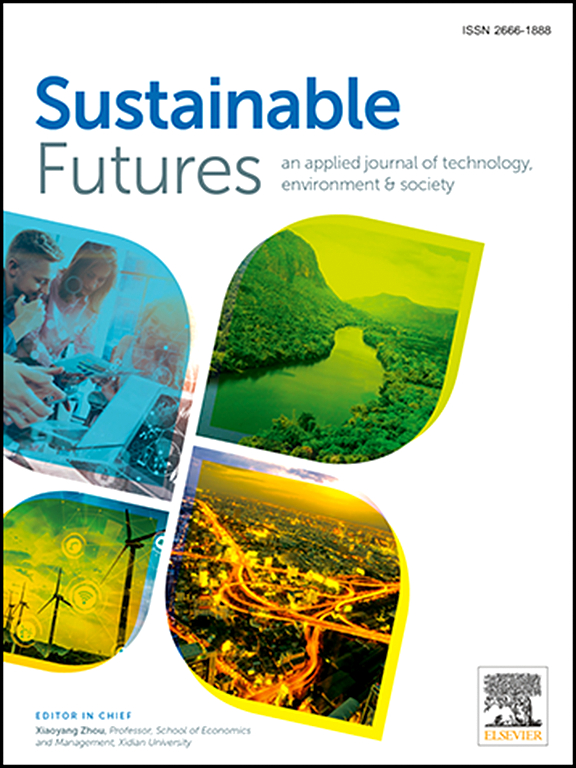Vision for Indonesia's 2050 power generation: Scenarios of hydrogen integration, nuclear energy prospects, and coal phase-out impact
IF 3.3
2区 社会学
Q2 ENVIRONMENTAL SCIENCES
引用次数: 0
Abstract
Indonesia's energy sector faces critical challenges due to its heavy reliance on coal as the dominant power source, which contributes to environmental degradation and rising CO2 emissions, resulting into transition needs for renewable energy as targeted inside Nationally Determined Contribution (NDCs) 2060. In addition to these, hydrogen energy also shows great potential for Indonesia's energy needs. However, to date there are no extensive research in Indonesia that simulate the effect of hydrogen incorporation and coal phase-out policy for 2050 power generation system, making this research a critical contribution to the exploration of Indonesia's energy landscape. This study utilizes the Low Emissions Analysis Platform (LEAP). There are four simulated power generation scenarios in this study: the business-as-usual (BAU) scenario, the hydrogen incorporation (HYD) scenario, the coal phase-out (CPO) scenario and the progressive (PRO) scenario. The analysis indicates that the BAU scenario emerges as the most cost-effective approach for meeting Indonesia's future electricity demand. However, due to its inability to fulfill NDCs, the CPO scenario is shown to be more viable from practical and cost perspectives, requiring 406.9 GW capacity and USD 114.6 billion investment. On the contrary, The HYD scenario largely aligns Indonesia's hydrogen target, potentially contributing 1–5 % of energy demand and reducing coal reliance. Additionally, while the PRO scenario has the highest investment cost (USD 151.4 billion), it also provides the lowest plant capacities (367.1 GW), offering the highest output-to-capacity ratio. The result suggests the necessity to enact government collaboration and construct feasibility analysis to implement renewable energy development.
印尼2050年发电展望:氢能整合情景、核能前景和煤炭淘汰影响
由于严重依赖煤炭作为主要电力来源,印度尼西亚的能源部门面临严峻挑战,这导致环境恶化和二氧化碳排放增加,导致对可再生能源的过渡需求成为国家自主贡献(NDCs) 2060的目标。除此之外,氢能也显示出印尼能源需求的巨大潜力。然而,到目前为止,印度尼西亚还没有广泛的研究模拟氢结合和煤炭淘汰政策对2050年发电系统的影响,这使得这项研究对探索印度尼西亚的能源格局做出了重要贡献。本研究利用低排放分析平台(LEAP)。本研究中有四种模拟发电情景:照常运营(BAU)情景、含氢(HYD)情景、煤炭淘汰(CPO)情景和渐进(PRO)情景。分析表明,BAU方案是满足印尼未来电力需求的最具成本效益的方法。然而,由于无法实现国家自主贡献,从实际和成本的角度来看,CPO方案更可行,需要406.9 GW的容量和1146亿美元的投资。相反,HYD方案在很大程度上符合印度尼西亚的氢目标,可能贡献1 - 5%的能源需求,并减少对煤炭的依赖。此外,虽然PRO方案的投资成本最高(1514亿美元),但它也提供了最低的工厂容量(367.1吉瓦),提供了最高的输出容量比。结果表明,实施可再生能源开发需要政府合作和构建可行性分析。
本文章由计算机程序翻译,如有差异,请以英文原文为准。
求助全文
约1分钟内获得全文
求助全文
来源期刊

Sustainable Futures
Social Sciences-Sociology and Political Science
CiteScore
9.30
自引率
1.80%
发文量
34
审稿时长
71 days
期刊介绍:
Sustainable Futures: is a journal focused on the intersection of sustainability, environment and technology from various disciplines in social sciences, and their larger implications for corporation, government, education institutions, regions and society both at present and in the future. It provides an advanced platform for studies related to sustainability and sustainable development in society, economics, environment, and culture. The scope of the journal is broad and encourages interdisciplinary research, as well as welcoming theoretical and practical research from all methodological approaches.
 求助内容:
求助内容: 应助结果提醒方式:
应助结果提醒方式:


